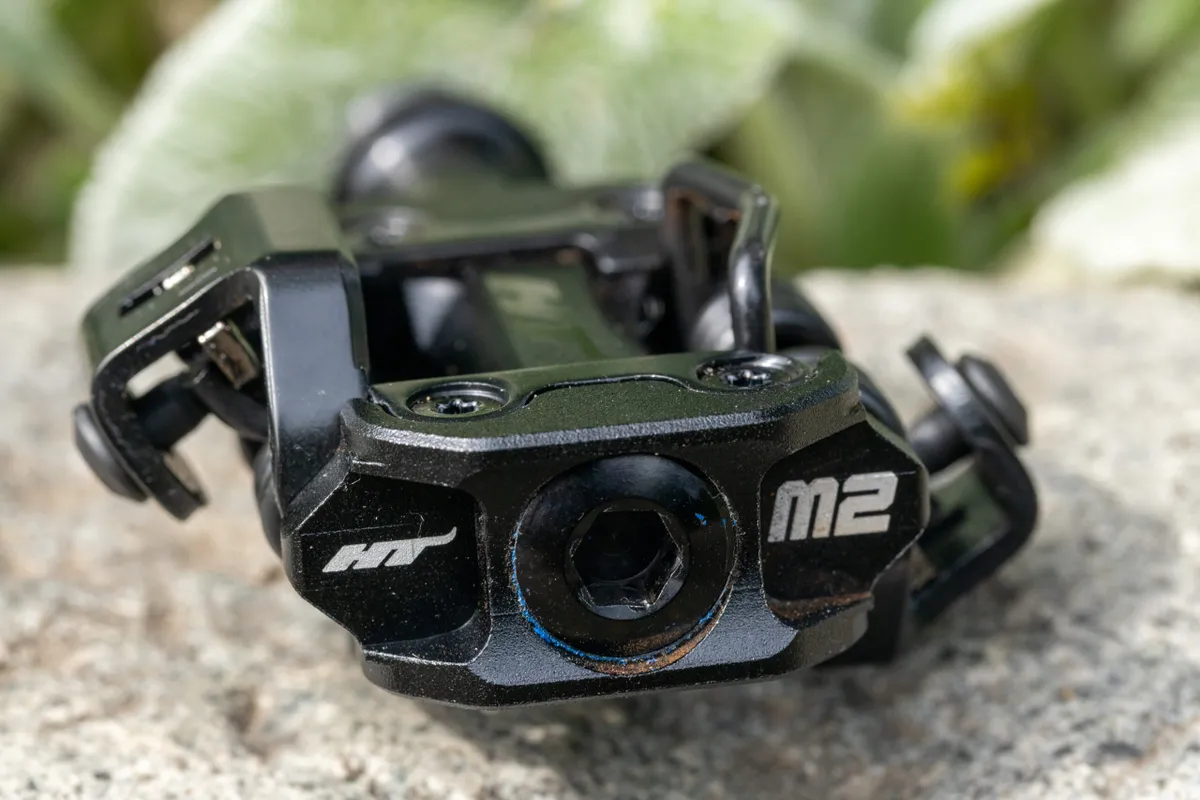HT’s M2 pedals are the Taiwanese brand’s open-cage option, designed for cross-country and gravel riding.
In testing, these pedals proved easy to live with and shed mud easily.
However, the finish on the test sample wore off quickly.
HT M2 pedals details

The M2 looks almost identical to a Shimano SPD pedal, with an open-cage design to help shed mud.
The HT pedals feature a dual-sided mechanism to clip into, with a 3mm hex tension-adjustment bolt on either side of the pedal body.
Rather than having to count the turns of a hex key, there’s a handy scale on each side of the pedal body so you can make sure the tension is identical on each side.

The aluminium pedal body is paired with a CNC-machined chromoly spindle. Sealed bearings with IGUS bushings are specced inside.
The pedals have a 54.5mm Q-factor and are claimed to weigh 305g a pair – I weighed them at 312g.
HT supplies both its X1 and X1E cleats in the box. Both cleats have 4 degrees of lateral float, with the silver X1E said to have an easier disengagement tension from the pedal. I prefer a cleat with harder engagement, so I opted to fit the black X1 cleat.
It’s commendable that you’re given the choice, rather than having to shell out for an alternative pair of cleats, which adds to the overall cost.

The M2 pedals are also compatible with HT’s X1F and X2 cleats – the X1F offers more float at 8 degrees and the X2s are also 4 degrees but have an even harder engagement than the X1.
The M2s are available in a whole host of colours to match your bike – Stealth Black (which I have on test), Grey, Silver, Red, Orange, Gold, Apple Green, Marine Blue, Royal Blue, Turquoise, Purple and Oilslick.
HT also makes the M2T, which uses a titanium spindle that’s claimed to weigh 260g. You’ll pay for the privilege here, because the price hikes up to £205.61 / $234.
HT M2 pedals performance

I’ve been testing the M2 pedals since the end of last summer and have clocked up 1,000 miles on them. They’ve been tested predominantly on gravel rides, with the odd bit of mountain biking thrown in for good measure.
This winter has been particularly cold and wet, and while long-term durability is impossible to measure in the scope of a single review, the pedals have been submerged through long flooded sections of road and trail as well as lashings of mud.
The HT M2s were tested using Sidi Dust MTB shoes.

The M2s were easy to set up, simply installing with an 8mm hex key once I’d applied some anti-seize to the threads.
From the first ride, the pedals felt virtually identical to the Shimano XT M8000 pedals I typically use, only with a slightly more defined entry when you clip in.
Finding the engagement point was easy and I didn’t have to think about what my feet were doing. The tension mechanism keeps a reassuring grip on the cleats.
The M2s would be ideal for stiffer shoes, thanks to their diminutive platform and open-cage design. They're well suited to cross-country or gravel racing.
Although I experimented a little with the tension during testing, I was happiest when using the default setting, around four-fifths of the way towards the firmest setting.
There were two occasions when I struggled to clip in because of mud build-up on sloppy rides – that’s pretty good going considering the waterlogged, boggy trails they’ve been subjected to. In my opinion, that performance is as good as, if not better than, other cross-country and gravel pedals.
Maintenance is relatively straightforward, but slightly more involved than Shimano pedals.

To remove the axle, you need to take out the 6mm hex bolt on the outside of the pedal body and then fully undo the 6mm nut. The axle can then be removed and HT recommends coating it with “a high quality thick grease”.
On a Shimano pedal, you simply undo the 17mm lockring to gain access to the axle.
I opened the pedals up towards the end of testing – the bearings felt close to factory-fresh, but needed some additional grease.
If you ever need spares, HT stocks bearing rebuild kits and axles, so they should last a long time (if well-maintained).

My only real qualm with the M2 pedals is the finish wore off very quickly, and each pedal looks quite heavily used after only 1,000 miles (1,600km) of riding. Of course, metal cleats on a metal pedal body will scuff, but my Shimano pedals look less tatty after seven years of riding.
A replacement set of cleats is also marginally more expensive than Shimano, but mine are still in good nick (as one would hope) and don’t look as though they’ll need replacing any time soon.
HT M2 pedals bottom line

HT’s M2 pedals are strong performers and were fuss-free throughout the testing period.
They’d be a great option if you’re looking to add some colour to your bike, although expect the finish to likely wear off quickly if you subject them to a tough life.
That said, Shimano’s XT PD-M8100 pedals retail for only £15 more (or $15 less in the USA, interestingly). That would be where I’d spend my money given the improved commonality of spares, easier maintenance and a more wear-resistant finish.
Product
| Brand | Ht_components |
| Price | A$199.95, €131.00, £99.99, $140.00 |
| Weight | 312g |
Features
| br_cleatTypepedalSystem | spd |
| Features | 54.5mm Q-factor |
